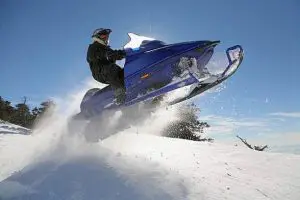
Learning new snowmobile tips and tricks can be the key to unlocking your optimum snowmobiling mastery.
Snowmobiling can be quite tricky and adventurous the same time. Failure to get yourself familiar with different techniques can hinder your adventuring and progress greatly.
To be at the top of your game, it is vital to learn and master new ways of doing things so you don’t get stuck in a routine.
Whether you are a newbie or an expert at the sport, learning new snowmobile tips and tricks will benefit you a lot. Often times, you may feel a desire to explore new terrain, try new things and even partake in a contest.
Snowmobiling becomes more adventurous and fun when you leave your comfort zone to explore new terrains and trails and in doing this, you need to have a good understanding of tips and tricks which you’ll find handy when you encounter different scenarios.
To help you up your game and transition to becoming a better snowmobiler, we have outlined top 20 tips and tricks that can help you take your game to the next level.
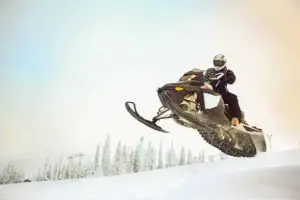
Table of Contents
Don’t overthink your situation
Trees aren’t surprising, you’ll come across them most times while riding, and they’re usually at the spot you’ll like to ride on. Don’t stare at them; you will hit them frequently. View the tree, notice the tree, focus on the path around the tree and ride on.
Dress Appropriately
Just like you take time to make the proper choice of clothes and accessories to wear on a date, it is also essential for you to make a good choice of clothes and gear when you are going snowmobiling. Snowmobiling becomes safer and more enjoyable when you stay dry and warm throughout. Unlike the common practice of eating and drinking every second to stay warm, clothes and protective gear are better alternatives.
When you are going for a ride in the snow, there are certain things you need to consider as far as your dressing is concerned. First off, you need a perfect snowmobile jacket that will safeguard you from harsh environmental elements. Some snowmobile jackets are water and wind-resistant with a high rate of insulation. Opting for these jackets will make your ride more comfortable.
Another healthy option you can choose is to dress in layers. It is, however, vital that you avoid snowmobile suits made of cotton materials. This is because cotton is easily prone to get wet, which can make you freeze.
Your palm and hands need to stay warm as well. Thus, it would be best if you got some gloves that will do that for you. Your face needs some protection, too. You can get that protection with an ideal face shield or goggles. Other accessories you can wear to complement your dressing include winter boots, winter hats, and socks. Above all, make sure you dress for convenience.
Watch out for other riders
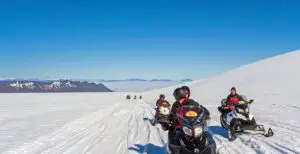
One thing you must note when snowmobiling, whether alone, with a friend, or in a group, is to avoid riding too closely. Ridding too closely with friends is the common cause of accidents. These accidents can be hazardous, so put it in mind not to ever follow too closely. When riding in groups on trails, ride single file; not closely.
Find your confidence in small wins
Get accustomed to the basic skills before jumping into video highlight reels. Naturally, you sometimes feel like you aren’t doing enough. However, you should also know that the feat you’ve achieved in snowmobiling is what another individual is struggling with. If you want more fun, go for it. You can only get better at the act.
Take your first tour with experts
Snowmobiling might not be an excellent challenge mechanic _ wise; however, staying all day out there in snow and wilds might feel daunting. Note that there are dangers out there. However, in the company of a good guide, those dangers easily vanish. So while learning avoids ridding too far on your own.
Permit yourself to get stuck
Getting stuck while riding is pretty normal, just like any of your group can get stuck too. According to the proper sled etiquette, assist anyone you can to get their snowmobile unstuck, and in return, you’ll receive help too. Remember learning from different people how to get unstuck can go a long way in helping you.
Try not to bring a passenger your first time
Learning how to ride a snowmobile is easier when you focus on yourself. Another rider may not make you feel that pleasure, which may steepen the learning curve. While learning, if possible, go alone, but, if not possible, relax and learn the feel of your snowmobile before you start riding.
To make this more relatable, ensure you take time to check the producer’s guide. Usually, the guide comes with an approved number of passengers. To make the guide comprehensive enough, the producers also include the weight suitable for the snowmobile. Bringing a passenger with you during your first snowmobiling experience will not only impede your learning process but will also put your safety and the snowmobile’s condition at risk.
Start Slow and Steady
Snowmobiling can get pretty exciting. When the chills and thrills are getting more intense, the speed is likely to increase. But the speed doesn’t guarantee the fun. Once you begin to ride at a relatively high speed, you are likely to sustain injuries or cause a lot of harm to your health.
Therefore, you need to ride at a slow and steady pace to react to sudden occurrences resulting in an accident. To help you keep this in mind, producers attach a speed limit to every snowmobile. While snowmobiling, ensure you do not ride above the speed limit.
Keep Your Snowmobile in Good Shape
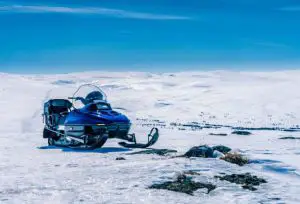
The condition of your snowmobile is of utmost importance. If you want to get the best of your snowmobile, you need to ensure that it is in good shape. To effectively do that, make sure that you:
- Carry out proper break-in by checking the oil levels of the engine
- Tighten the bolts, check the wear components to know if they are in good shape, and clean the clutches.
- Wash and clean the sled after each trip to prevent the metal components from rusting.
- Store the snowmobile correctly by greasing the metal parts and putting fuel stabilizers, especially during the off-season.
- Use quality oil for your snowmobile engine.
- Practice frequent warm-up before you put out the snowmobile for use.
Make Provision for First Aid Kit
Accidents are inevitable during an activity as engaging as snowmobiling, and the chances of people sustaining an injury are pretty high. This is the primary reason you need to have a first-aid kit at your disposal each time you go for a ride.
You do not need to get the kit stacked with too many materials. Simple equipment and substances such as hand sanitizer, disinfecting wipes, Band-Aids, bandages, adhesive tape, and gauze are good enough.
Emergency and Repair Kits
Like the first-aid kit, the emergency kit is also very indispensable. In the case of an emergency, you can easily reach out to one of the materials in the kit to get yourself back on track. You can include snacks, water, matches, blanket, flashlight, map, and compass in the emergency kit.
You should also create space for a repair kit. Keep valuable items like tow rope, duct tape, spare belts, spark plugs, and other necessary tools in the repair kit.
Biorhythms
Like other sports where there are good and bad days, snowmobilers can also go through off days during their rides. Remember when you need to slow down to react, and you’re always on the wrong side of your sled. Just like many other sports, once you start making mistakes, it isn’t easy to stop. Face it; there are times when riding isn’t so smooth. You made a mistake, and you lost confidence in your riding capabilities. It’s pretty normal, and it usually occurs when you’re riding on new trails or with riders you’re not familiar with. When in a situation like this, take a little time, ride with a bit more control. Leave others to do the show-off; focus on yourself.
Avalanche

While riding in the mountain, the feeling of the mountain falling on you is inevitable. Whether or not you have experienced an avalanche before, know there are chances you would. In preparation for that, we advise you to go with three essential items. A beacon, which helps to send the signal out if you’re stuck, others can reach you, or it’s switched to receive a signal, so you can reach another rider that’s stuck. A shovel, which is most common among snowmobilers, and the probe only serves one purpose, and that’s to probe.
Sidehilling
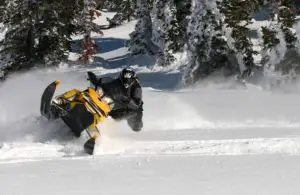
Sidehilling is the ability to control your snowmobile while riding on a very unlevel slope which is often quite challenging. The part that makes sidehilling challenging is usually the terrain. You have just two options to choose from: either you cut the sidehill and reach where you intended to go, or you wash the sidehill and get to where you didn’t plan to go. Washing your sidehill means that your snowmobile starts heading down, and you don’t have the strength to control it.
Hill climbing
Hill climbing is common to most western riders to determine who can climb higher on a steep mountain slope. Two things should take place, you either go up, or you come down. Anything else isn’t always good. There are many unwritten rules guiding hill climbing, so a rider needs to decide when it’s the right time to turn back down. A one-time hill-climbing experience can give you a sense of fulfillment and make you want to try over and over again. It is advisable to go hill climbing in the view of other people, to get help in case of an emergency.
Plan B
As a snowmobiler, your ability to think, act, and react is your biggest asset. No matter what you do, prepare for unforeseen circumstances. Before facing any challenges on the trails, think about the worst that could happen. If you have a second plan, your chances of experiencing unattractive results are very slim.
Adjustable thumbs
No matter how great your strength is, if you only know how to take a fistful of throttle, then you might have a problem with mountain riding. Most riders don’t understand the difference between horsepower and power band. Big horsepower snowmobiles are usually hard to control because when you crack its throttle, it explodes beneath you, unlike snowmobiles with less horsepower featuring a powerband that can wind up.
Way to go
So, you’re wondering how it’s possible to ride on the same trails for years, starting together with the same group of people but still end up a bit confused about where you are or why someone got missing during the ride. Well, snow changes things. Starting from the first day, new snow can clean old tracks and cover trails and landmarks. Things appear differently. The best thing to do is to set up standard guidelines that everyone is on a similar page. If anyone ever gets lost, go back to the last place where everyone was together and wait. The search can begin here and hopefully lead you somewhere.
Descending hills
As we all know, what comes up must come down. When you’re going straight down, you’re not able to control it unless you hit an unmovable object before it stops. Ironically on some descents, the only control you have over your sled is with your throttle and not the brake. Once a track is closed, the lugs in the pattern are full; you’re sliding on snow with no traction. This is why you need to maintain rigid balance as a rider as you are coming down the hills.
Other things to remember
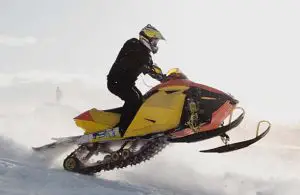
To crown it all, follow the law, use common sense, and pay attention to your surroundings. It is important to be on the alert whenever you are snowmobiling. Just like drinking while driving makes you more susceptible to having an accident, drinking while snowmobiling is not too different.
Final Thoughts
You can make your snowmobile getaway more exciting when you master new snowmobile tips and tricks. The recommendations outlined in this guide will help you become better, improve your game and make your fun rides more exciting.
Leave a Reply